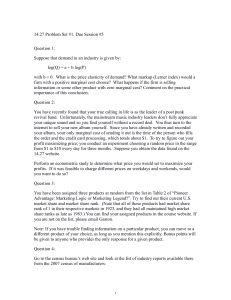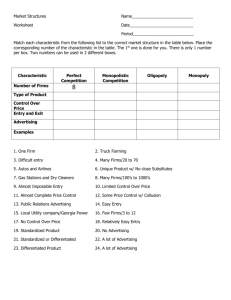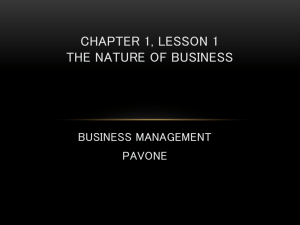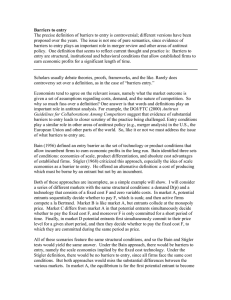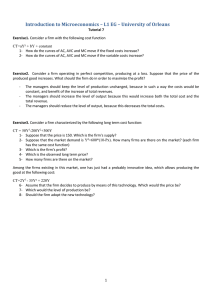Problem Set 4 Due Wednesday, May 7 by 1 p.m.
advertisement
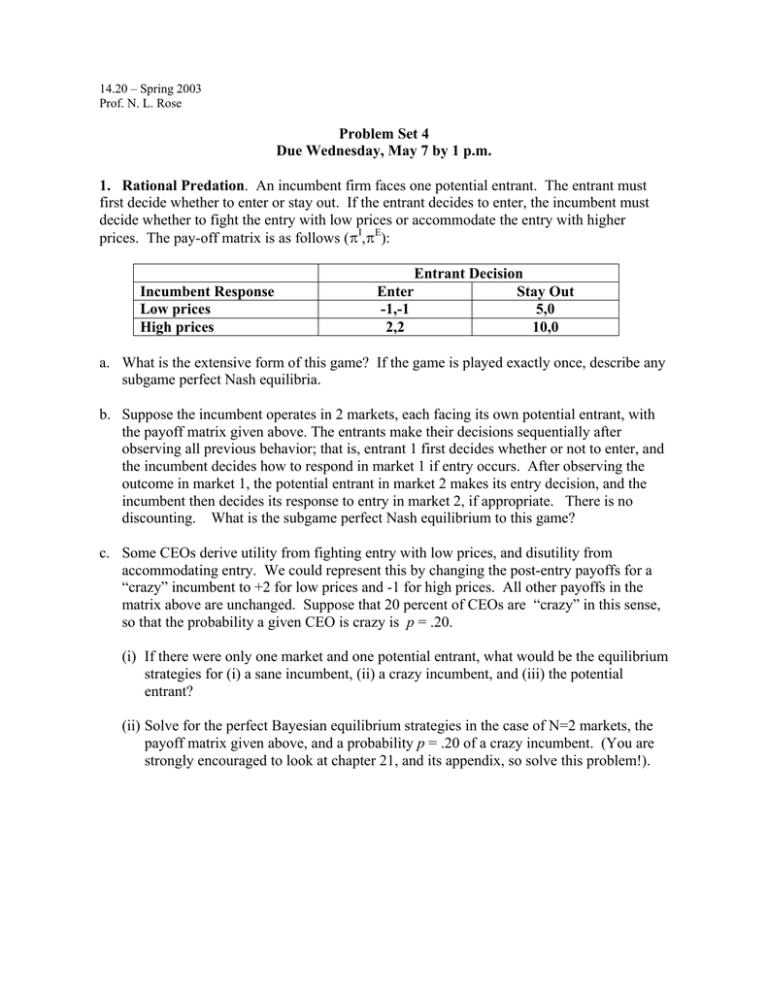
14.20 – Spring 2003 Prof. N. L. Rose Problem Set 4 Due Wednesday, May 7 by 1 p.m. 1. Rational Predation. An incumbent firm faces one potential entrant. The entrant must first decide whether to enter or stay out. If the entrant decides to enter, the incumbent must decide whether to fight the entry with low prices or accommodate the entry with higher prices. The pay-off matrix is as follows (BI,BE): Incumbent Response Low prices High prices Entrant Decision Enter Stay Out -1,-1 5,0 2,2 10,0 a. What is the extensive form of this game? If the game is played exactly once, describe any subgame perfect Nash equilibria. b. Suppose the incumbent operates in 2 markets, each facing its own potential entrant, with the payoff matrix given above. The entrants make their decisions sequentially after observing all previous behavior; that is, entrant 1 first decides whether or not to enter, and the incumbent decides how to respond in market 1 if entry occurs. After observing the outcome in market 1, the potential entrant in market 2 makes its entry decision, and the incumbent then decides its response to entry in market 2, if appropriate. There is no discounting. What is the subgame perfect Nash equilibrium to this game? c. Some CEOs derive utility from fighting entry with low prices, and disutility from accommodating entry. We could represent this by changing the post-entry payoffs for a “crazy” incumbent to +2 for low prices and -1 for high prices. All other payoffs in the matrix above are unchanged. Suppose that 20 percent of CEOs are “crazy” in this sense, so that the probability a given CEO is crazy is p = .20. (i) If there were only one market and one potential entrant, what would be the equilibrium strategies for (i) a sane incumbent, (ii) a crazy incumbent, and (iii) the potential entrant? (ii) Solve for the perfect Bayesian equilibrium strategies in the case of N=2 markets, the payoff matrix given above, and a probability p = .20 of a crazy incumbent. (You are strongly encouraged to look at chapter 21, and its appendix, so solve this problem!). 14.20 – Spring 2000 P. S. 4 - page 2 2. Advertising. Suppose the demand for a new pharmaceutical drug, on which the manufacturer has a patent monopoly, is given by: Q(P,A) = (100-P)*A. 5 where Q is output per period, P is the price, and A is the current period promotional expenditures. Production costs are given by: C(Q) = 60Q a. Calculate the profit-maximizing price, advertising level, and profits for the firm. b. At the firm’s optimal choices, what is the: (i) price elasticity of demand, (ii) advertising elasticity of demand, (iii) advertising/sales ratio for this product? 3. Tobacco Advertising Discussion. The cigarette industry, like many others, creates and sustains product differentiation through substantial advertising and promotion expenditures. In the 1960s, tobacco firms were banned from advertising on television. In late 1998, tobacco companies expected the multi-state tobacco litigation settlement to impose additional limits on cigarette advertising and promotion. Read the article “Cigarette Makers in Discount War to Lock in Share,” Wall Street Journal, September 23, 1998, B1. Answer the following questions. They will be discussed in class on Monday, April 28. a. How might advertising by a particular company affect that firm's sales and cigarette demand overall? b. Explain how you would expect a ban on cigarette advertising to affect the profitability of: (i) existing “strong” (high market share/ market recognition) cigarette brands; (ii) existing “weak” brands (low market share/market recognition); and (iii) potential new entry of brands. c. What incentives are implied by (b) for short-term price and advertising strategies in advance of an expected mandated industry-wide reduction in advertising? d. Would you expect the price behavior described in the article to be permanent or temporary? Explain. 4. R&D. Suppose two firms produce USB memory keys. Demand for these keys is given by P = 100 – Q. Both firms have access to a technology that enables them to produce keys at a constant average and marginal cost of $15 each. Assume that the market for these keys is expected to last 5 periods, that there is no growth expected in demand or costs over this period, and that the discount factor is 1.0 (no discounting). 14.20 – Spring 2000 P. S. 4 - page 3 a. Assume that the firms compete in a static Cournot (quantity-setting) game. (i) (ii) (iii) (iv) (v) What are the equilibrium quantities, price, and profits? Firm 1’s engineers believe they can develop a proprietary technology that will reduce costs to a constant average and marginal cost of $10 per unit. How much should firm 1 be willing to pay to develop this technology if it does not expect firm 2 to have access to this technology ? Explain your answer. What is the social value of developing this technology? Social Value = )Consumer Surplus + )ΣB Suppose firm 2 could develop a “copycat” technology with identical costs to firm 1 (MC = AC = 10). How much, if anything, should it be willing to spend to develop that technology? Explain. What is the social value of developing the copycat technology? b. Assume instead that the firms compete in a static undifferentiated product price (Bertrand) game. (i) (ii) (iii) (iv) (v) What are the equilibrium quantities, price, and profits when both firms use the old ($15 MC) technology? What are firm 1’s incentives to develop a proprietary technology with marginal costs of $10 per unit, assuming firm 2 will not have access to the technology? What is the social value of developing this technology? What are firm 2’s incentives to develop a copycat technology with identical costs to firm 1 (MC = AC = 10)? What is the social value of developing the copycat technology? c. Which form of competition (quantities or prices) provides stronger innovation incentives for firm 1, given that both firms were initially using the old technology (MC = 15)? Can you provide an intuition for this result? Which form of competition provides greater social incentives for developing the original cost-reducing technology? d. Compare the private and social incentives for developing the copycat technology under price and quantity competition. Provide a brief explanation of why the results are similar to or different from those in part (c). 5. Incentives & Strategic Choices. Suppose that two firms compete in quantities, facing a market demand of P = 20 – Q and constant marginal costs of 2. a. What are the equilibrium quantities and profits of each firm? 14.20 – Spring 2000 P. S. 4 - page 4 b. Suppose that output decisions are made by income-maximizing managers who are hired by the firm’s shareholders, and are paid a share of profits, α.B. How will this change the equilibrium quantities and profits of the firms, if at all? c. Suppose that firm 2’s shareholders change the pay scheme for the CEO of their firm to β* (total revenues). How would this change the equilibrium quantities and prices for the firms? Provide intuition for this result. Would you expect firm 1’s shareholders to change to this compensation scheme? Why or why not? d. If firms instead competed in a differentiated products Bertrand pricing game, would it generally be advantageous or disadvantageous to shift CEO compensation to the form described in (c)? Explain your answer qualitatively, with reference to the strategic commitment taxonomy we discussed in class (puppy dogs, fat cats, etc.).
